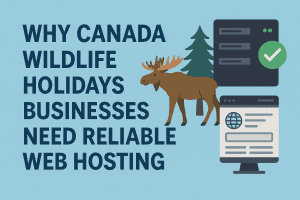These days it’s increasingly common for e-commerce retailers to be expanding their horizons and aiming to move beyond having only a domestic customer base. The Internet has been a boon in every sense of the word when it comes to making this very much possible, and manufacturers, retailers, and consumers all stand to benefit greatly from what is now a global marketplace.
Here at 4GoodHosting, we’re not unlike any top Canadian web hosting provider in the way that a great many of our customers are retailers who rely on their website - and their web hosting - as an integral part of their digital marketing resources. The need for quality and competitive pricing is a given, but in the information age it’s equally as important to have yourself standing out from the crowd online when most consumers rarely make it to a 2nd or 3rd page of search engine results.
If your business is one aiming to sell internationally, then your search engine optimization (SEO) efforts need to be tailored to that aim. International SEO can be complicated as there are multiple countries with multiple languages, and often multiple languages within a given country. It inherently becomes much more difficult than focusing on the domestic market, and it’s not something that you can turn to a translator to correct.
It is possible to gear your SEO to be ‘internationally effective’, with a little planning and the right approach for your unique situation.
Here are ways you can target international customers and make wise decisions when it comes to ranking in multiple countries.
What Makes Up international SEO?
International SEO involves organizing and optimizing your webpages to allow search engines to identify the countries you are targeting, incorporating specific content and language for each user in a given location. In many ways, it is similar to how we provide SEO for small businesses that target multiple locations, with the fact they are often organized by towns, cities, municipalities or entire provinces.
Domain names for international SEO
There are some primary considerations when choosing a domain name for your international SEO campaigns.
Certain domains, referred to as country code top-level domains (ccTLD), will default to a specific location. Other top-level domains (TLDs) give you the option on geotargeting them to point at specific countries. The sub-folders and subdomains on these TLD domains can also be geo-targeted to specific different countries.
You must ensure you have the correct domain for your international SEO requirements.
It’s not a simple matter to make these determinations though.These rules are often loosely in place, and one such example is when you are promoting content with SEO. Even ccTLD domains or geotargeted TLD domains can rank informational content internationally, but they won’t do so on their own unless they’re geared for it.
For example, let’s say your company operates out of the Toronto, but has customers all around the world. The majority of your customers are finding you through articles on our blog, which runs on a CAD (Canadian) ccTLD. Those numbers may be sufficient and consistent,, but this is not to say you should disregard geotargeting; for the majority of industries, it’s not the right approach. Ranking internationally is about providing the right content for the right audience, and audience predispositions for content will vary.
You want to be certain that Google does not become seriously confused with what-may-be several versions of your site and bury you in SERPs.
How to target a specific country
Here’s a basic checklist for targeting a specific country with international SEO:
- Use a country-specific domain
- Specify the location you are targeting in Google Search Console
- Register your business address with Google My Business
- Include the street address of the business on the website
- Host the website locally (as much for usability as for SEO)
- Get links from country-specific websites
- Use local language(s)
The aim is to send a clear signal to Google about where you operate and who you’re hoping to have see and interact with your content. You want as many indicators and prompts as possible, so try to include all items on the checklist.
International SEO strategy
It’s common for most international SEO efforts to include targeting of multiple countries, which means you must scale your approach to address and cover all desired locations.
There are a number of ways to approach this, and some will be suitable for your situation while others will not. Here are two approaches that will almost certainly be effective for the majority of serious international SEO efforts.
Content marketing - We now know that targeted content marketing can help pages rank internationally, even from a ccTLD site. If you are able to generate leads through content, then promoting your content with SEO can be the simplest option. This isn’t difficult if you have a defined audience and some measure of professional authority with your content, but you must also make sure this is a viable business model for your company. It’s typically a good fit for companies that are well established online, but for more traditional businesses that are not as solidly set in the digital realm this is often not the best choice.
Single TLD site - Some industries will present automatic international search results. This is often true of niche businesses that rank fairly well across English-speaking countries but even without International SEO optimization. Should they want to focus on international SEO, it’d be quite easy to do that with a more traditional SEO process.
Of course, do your research before you wade into a complex international setup.
Subfolders and Geo Targeting - For those requiring country-specific content, one of the easiest options is to create localized sub-directories on your own site. These sub-directories can be geotargeted in Google Search Console and may include country-specific content and language. Here are examples:
- example.com — root site targeting the USA.
- example.com/uk/ — UK.
- example.com/de/ — Germany.
There are three key benefits to taking this approach. First off, you are only expanding your existing site and that will likely mean less technical management and overhead, e.g., hosting.
Secondly, your sub-directories will inherit authority from the parent domain.
Third, you only have one site to promote, and so while you will want country- and language-specific links, going this way is still simpler and more cost-effective than promoting multiple sites.
Keep in mind though that users may not recognize geotargeting from the universal resource locator (URL), and you’ll have a single server location. So yes, it’s a relatively easy way to get started with true international SEO, but be aware of the limitations of this approach.
Country-specific domains- Here you can use country-code top-level domains (ccTLDs) or subdomains on a TLD. Both will take you to the same objective with your International SEO.
- Geo-targeted subdomains. These TLD subdomains must be geotargeted in Google Search Console:
- example.com — US
- example.com — UK
- example.com — Germany
- Country-specific ccTLD domains. The country associated with the ccTLD is automatically targeted:
- com — US
- co.uk — UK
- de — Germany
Businesses with a physical presence, operation or local offline marketing in the target country will usually find this to be the best approach. But it may not be the most cost-effective one, as each site must be configured and marketed independently. This is typically done by the local marketing team.
Both approaches allow the business to use local web hosting and build clear location signals with country-specific links to the URL. This is ideally what you should want and should be considered when making a decision to enter a competitive international market, especially one where you are competing with companies that are resident in that country.
Using ccTLDs here is preferable to subdomains if that’s something you can do. However, it requires you to own all the international ccTLD versions of your domain. If you can make that happen, it will provide big branding benefits where users prefer to click on their own ccTLD.
Folks in specific countries will of course prefer domains that indicate their home country, as well as be more trusting of them. SEO is just part of a larger conversation, making it that the right approach should be determined by the wants and needs of the target customer.
Subdomains are thus not as popular because users may not recognize or understand the domain and that could impact trust and click-through rates.
If money is no object and you are taking a long-term committed approach to the International visibility of your business online, we definitely recommend going the ccTLD route.
One last important consideration here is to remember that any problems can be multiplied across your entire portfolio of sites. Make sure your initial site is technically perfect in advance of you creating international sites.
URL variables
There’s also another option worth mentioning here, which is using URL variables like country=ca. While it’s doable, Google’s own page on multi-regional and multilingual sites states it’s not a recommended course of action.That’s primarily because this option cannot be geotargeted, and it’s easy to see how that would take away a lot of the potential exposure power you’re after.
This has been an overview of the options for international SEO. Your objectives, budgets and you marketplace will define what’s right for you, but be sure to work with these guidelines if you’re going to go it alone and work with your existing knowledge of SEO.
Of course, if we can be of assistance in any way - please don’t hesitate to ask!















